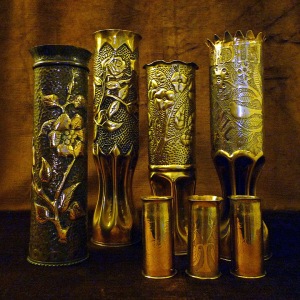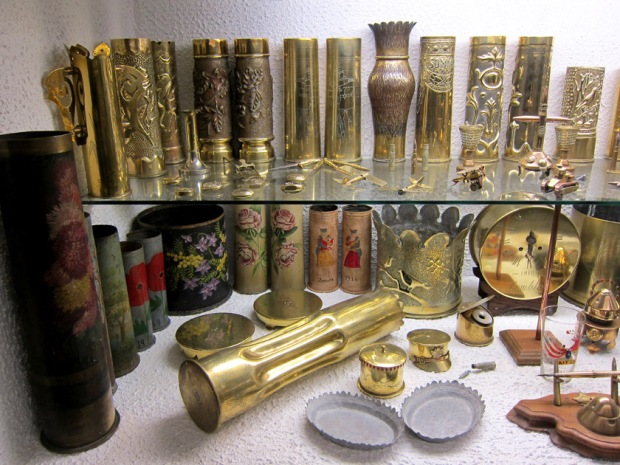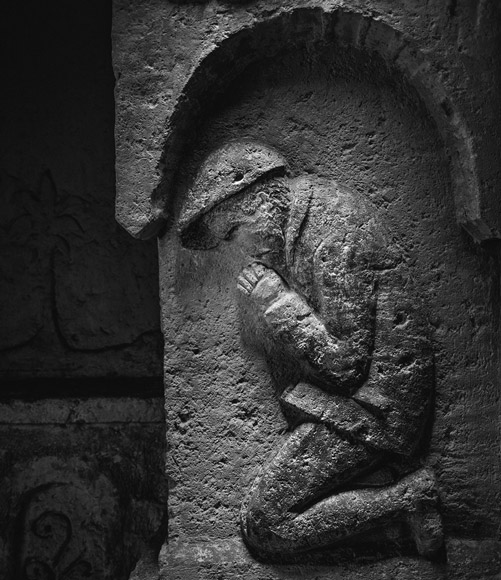Trench Art: Creativity in an Unexpected Place

The monthly ArtSmart Roundtable brings together some of the best art-focused travel blogs to post on a common theme. This month we are discussing War and Peace. I think you’ll find some really interesting articles on this topic, so take a look at the bottom of the page for them all.

The diverse collection of French World War I trench art at the Musee de Somme 1916 includes painted, cut, shaped, and hammered pieces.
Artists across cultures, time, and place have depicted war, from the vases of ancient Greece to the romanticized paintings of Napoleon’s campaigns. However a common thread is that these images of battle were created by those not involved in fighting, or were done years after the fact for patriotic or sentimental reasons. What we don’t often see is art created by soldiers in the midst of battle and experiencing the brutality of conflict. When they do create, often as a means of distraction, these pieces constitute a tiny genre called Trench Art.

Floral designs hammered into 75mm and 37mm shells from World War I France. (Photo: Wikimedia)
Trench Art itself is a type of Folk Art created by soldiers or prisoners of war with found materials. Since most of the men who created Trench Art are not trained artists, this material is also considered a type of Outsider Art. While art created in earlier conflicts is known, the phenomena really became prevalent during World War I in France. Forces were pinned down in miserable trench conditions for months. Surrounded by the mountains of spent cartridges, they began fashioning this metal to pass the time and as a diversion of their horrendous living conditions.

French soldiers shaping shell casings during World War I. (Photo: Wikicommons)
Most of these shells have been bent, carved, and pounded into shape using re-purposed tools and metal bits from the front lines. Images can range from rudimentary insignias or words to very elegant and complex flowers, animals, and abstract patterns. Military or patriotic imagery sometimes appear but organic subjects are much more prevalent. It’s hard to imagine roses, branches, and daisies in a war zone, but this is precisely what the soldiers were trying to remember. It’s the sentimentality and “non-conflict” designs of these shells that make them so fascinating to me.

Some “practical” items like a pitcher and desk ink set among the trench art on display at the Museum of Military History (Hadtorteneti Muzeum) in Budapest.
There is a steady market for and community of Trench Art collectors. French pieces from World War I are the most prevalent but its easy to find work from other earlier and later conflicts, and from both sides involved in the war. This little flash of creativity doesn’t seem limited to one particular nationality.

An anonymous image of a praying solider carved into a subterranean tunnel in France along what was once the World War I frontline. (Photo: Jeffrey Gusky, National Geographic)
Besides found objects, there are other artistic glimmers created during periods of battle. National Geographic recently did an excellent article about cave carvings discovered in France along the World War I frontline. There were some comical portraits of the prostitutes, the Germany enemy, and their own Allied commanders. But its hard not to be moved by the image above of the praying man. With his tightly folded hands tucked under his chin, you can feel his fear and almost hear his prayer. It’s an honest depiction of the emotions aroused by war. It’s much clearer now why soldiers made shell case flowers – they needed help escaping their surroundings, if even just for a moment.
For the rest of the May ArtSmart Roundtable, check out:
- Chris Dobson for ArtTrav – Sex, Violence and Parties: Politics in Renaissance Florence
- Pal & Lydian of Art Weekenders – How The Night Watch and Art In General Survived The Second World War
- Lizzie of WanderArti – Artists Around the World that Have Turned War into Art
And don’t forget to like our ArtSmart Travel group on Facebook for art & travel





That’s really fascinating, how did you ever find out about this?! The floral carved cartridges are particularly beautiful!
LikeLike
Thanks! Beside all their weapons and equipment, military museums always seem to have a piece or two of trench art that I just seem to zero in on. In Northern France, the antique shops have lots of trench art so it’s easy to find. I like folk art and outsider art so these kind of pieces just naturally popped up.
LikeLike
This is a really great interpretation of the theme Christina!
I keep my mail in an old hand made box which I purchased from someone who said it was made by their great uncle in the trenches. My dad and I love antiques and we are always amazed by what people are willing to part with at garage sales or for a bit of extra money.
LikeLike
Thanks! That sounds like a cool storage box you picked up 🙂 I love antiques because they come with stories, are made very well and look amazing.
LikeLike
This is so interesting! It never crossed my mind before what soldiers actually do in their free time. It’s great to read that the creative ones kept on expressing themselves like this.
LikeLike
Trench art really is like a little diamond in the rough; it is quite an optimistic commentary on the human spirit.
LikeLike